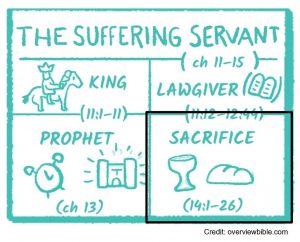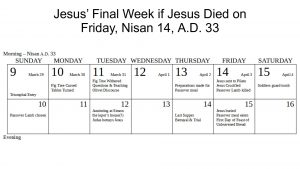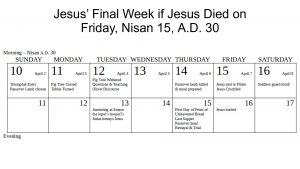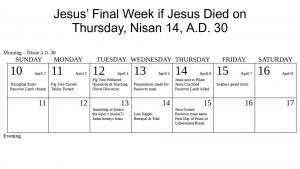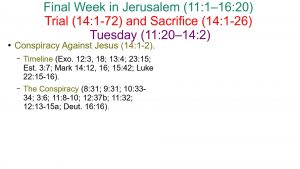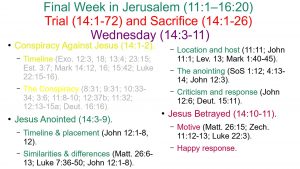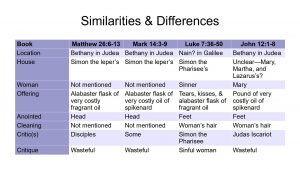Jesus’ Final Week in Jerusalem
Mark 11:1–16:20
Teaching (11:1–13:37)
King (11:1-11)
Sunday: Triumphal Entry (11:1-11).
Lawgiver (11:12–12:44)
Monday (11:12-19).
Tuesday (11:20–14:2).
Lesson from Fig Tree (11:20-26).
Jesus’ Authority Questioned (11:27-33).
Parable of Wicked Vinedressers (12:1-12).
On Taxes (12:13-17).
On Resurrection (12:18-27).
The Greatest Commandment (12:28-34).
An Unanswerable Question (12:35-37).
Warning About the Scribes (12:38-40).
Widow’s mites (12:41-44).
Prophet (13:1-37)
On Temple’s Destruction (13:1-30).
Heavens and Earth Pass Away (13:31-37).
Trial (14:1-72)
Sacrifice (14:1-26)
 Conspiracy Against Jesus (14:1-2).
Conspiracy Against Jesus (14:1-2).Timeline (14:1a).
The rest of this final week of Jesus is difficult to figure out.
First, we are talking about this here because the text says, “After two days it was the Passover and the Feast of Unleavened Bread.”
This does not suggest two days had passed, but that two days from then would be the Passover.
 We know Sunday, Monday, and Tuesday are taken care of since we just did them, and we know that He was raised on a first day of the week. The rest of the week is where the difficulty lies.
We know Sunday, Monday, and Tuesday are taken care of since we just did them, and we know that He was raised on a first day of the week. The rest of the week is where the difficulty lies.There are no time markers to indicate when Tuesday ends and Wednesday begins, or when Wednesday ends and Thursday begins.
Working backward, we know that He was crucified on the day before the Sabbath, known to many as Good Friday.
The day before Good Friday is known as Maundy Thursday when the Last Supper took place.
These are the traditional days of the week for which these events took place.
 The question then becomes when they took place.
The question then becomes when they took place.Recall that the Passover took place on the 14th day of the 1st month, called Abib in Exodus 23:15 (12:18; 13:4), but Nisan by the end of the Babylonian Captivity (Est. 3:7).
The Passover lamb was killed on that day and the meal was eaten that evening, technically on the 15th of Nisan, since the Jewish day began in the evening at sundown.
Since the traditional day of the crucifixion is Friday, the year that Nisan 14 landed on a Friday was A.D. 33. This makes the crucifixion April 3 and the resurrection on April 5.
But that leaves this day between the Olivet Discourse and the Last Supper where almost nothing happens, a Wednesday.
Two events are recorded as happening between them: Jesus’ anointing at Bethany and Judas Iscariot going to the chief priests to betray Jesus (14:3-11).
Because of the transition language, it’s possible that these things happened on Wednesday, surely the earliest would be the evening after the Olivet Discourse—though it could have occurred anytime that following day.
The problem with this is that in the Synoptic Gospels, Jesus appears to be eating the Passover with His disciples as His Last Supper, but here, He has died before that could happen (14:12, 16; Luke 22:15-16).
It would appear that, if we held to this timeline, then Jesus must not have eaten an actual Passover meal that night, but merely wished to. That night was just a normal meal.
 Not satisfied with that, there are two alternatives to this traditional view. The first places Jesus’ crucifixion on Friday, Nisan 15. That would make it the year A.D. 30 on April 7.
Not satisfied with that, there are two alternatives to this traditional view. The first places Jesus’ crucifixion on Friday, Nisan 15. That would make it the year A.D. 30 on April 7.This allows Jesus to eat the Passover meal with His disciples while He dies on the day after Passover during the Feast of Unleavened Bread.
It also moves up the day on which the Passover lamb was chosen to be on Sunday. On 10 Nisan, the Passover lamb was chosen to be sacrificed on the 14th (Exo. 12:3). It fits that this would be the day in which Jesus made His triumphant entry into Jerusalem. The people chose Him.
I contend that this still could have happened, since the entry occurred late in the day, and evening likely came quickly when the people chose.
But it also removes the parallel of Christ having died as our Passover Lamb.
 The other view places it in same year, but moves everything up a day.
The other view places it in same year, but moves everything up a day.The crucifixion then is placed on Thursday, Nisan 14, that is April 6.
This has several advantages: 1) it removes the “day of rest” Wednesday, forcing the anointing at Bethany and Judas’ betrayal to occur the evening following the Olivet Discourse, 2) it adds a day to Jesus’ interment, making it easier to count it out as three days and three nights, and 3) it better allows for the parallel of Jesus’ chosen as the Passover Lamb with the Triumphant Entry and His crucifixion with the sacrifice of that lamb.
But we still have the earlier problem of the Last Supper not being a true Passover meal.
It would also mean the Sabbath that is talked about as following the Preparation Day is the First Day of Unleavened Bread rather than Saturday (15:42).
For the purposes of this class, we will go with the traditional view.
This places the statement, “After two days it was the Passover and the Feast of Unleavened Bread,” as speaking of events that happened either the evening after the Olivet Discourse, or the following day.
If either of the other two alternatives were correct, then we could place these events happening during the day before the evening arrived.
This is possible, since it was the chief priests and scribes making this conspiracy no doubt after Jesus and His disciples left the temple to go to the Mount of Olives (13:1, 3).
Jesus had predicted His death at the hands of the chief priests and scribes three times already (8:31; 9:31; 10:33-34)
Now they were going to kick their plans into high gear, having begun as early as Mark 3:6.
Note, they could not take Him out by legitimate means, but had to use trickery.
You see, the people absolutely loved Him, as was evidenced by their reaction when He arrived into town on the back of a colt and listened to Him gladly (11:8-10; 12:37b).
They had tried several times using trickery with their questions in Chs. 11 & 12, but failed to best Him every time.
It was clear they feared the reaction of the people even before this point (11:32), and even tried to get the crowds to turn on Him with their questions (e.g. 12:13-15a).
They had to resort to deeds even more underhanded, and it makes you wonder. If you have to resort to such loathsome tactics to achieve your goals, maybe you’re the bad guy.
This was complicated by the fact that the feast was fast approaching, so very many Jews would be in Jerusalem that week to prepare for the Passover (Deut. 16:16).
Wednesday (14:3-11).
Timeline and placement.
Matthew and Mark both put this event in the same place, after the Olivet Discourse but before the Last Supper.
If that’s all we had, we would assume this would be when it occurred, but John records a very similar event (John 12:1-8).
The events are so similar that many think they are the same told from another perspective, but John gives a time statement for when this occurred.
He says it took place “six days before the Passover,” placing it on the Saturday before the Triumphant Entry into Jerusalem, which John records as happening “the next day” (John 12:12).
Luke also records a similar event much earlier in Jesus’ ministry, but the differences are so stark that it likely cannot be the same event.
We will go over some of those similarities and differences in a moment.
But first, if this event took place before Jesus entered Jerusalem, why would Matthew and Mark place it here?
Notice the sandwich that Mark does again here, by placing the plot in 14:1-2 and Judas volunteering to help in that plot in 14:10-11.
Recall, Mark loves to sandwich things like this, often to show a contrast between these events.
It contrasts this woman giving so much up for Jesus, while this man, this disciple is about to receive so much for Jesus—sacrifice & betrayal.
Sacrifice on the woman’s part, betrayal on Judas’s.
It also shows a possible motivation for Judas’s betrayal, because of the waste Jesus was comfortable with, particularly since Judas had his hand in the treasury (John 12:6).
Location – MMJ (Bethany in Judea); L (Nain? in Galilee).
House – MM (Simon the leper’s); L (Simon the Pharisee’s); J (unclear—Mary/Martha/Lazarus’s?).
Woman – MM (nothing specific); L (sinner); J (Mary, Martha’s sister).
Offering – Mt (alabaster flask of very costly fragrant oil); Mk (alabaster flask of very costly oil of spikenard); L (tears, kisses, & alabaster flask of fragrant oil); J (pound of very costly oil of spikenard).
Anointed – MM (head); LJ (feet).
Cleaning – MM (not mentioned); LJ (woman’s hair).
Critics – Mt (disciples); Mk (some); L (Simon); J (Judas Iscariot).
Critique – MMJ (wasteful); L (about woman being a sinner).
So, putting these things together, it would appear there were two different “anointings,” one happening in Galilee, and another happening in Bethany just before the Triumphant Entry.
The one we’re talking about took place in the house of Simon the leper, with Mary and Lazarus in attendance, while Martha was serving.
Some speculate that perhaps Simon was their father.
Mary is the one who anoints Jesus’s head and then His feet—she’s not named in Matthew 26 or Mark 14 because she’s not named elsewhere in those books.
She anoints Him with a very expensive perfume, spikenard, housed in an alabaster flask and wipes it off with her hair.
The disciples, especially Judas Iscariot, are critical of what they perceive to be a waste. At least, that’s the reason Judas gives for his criticism.

